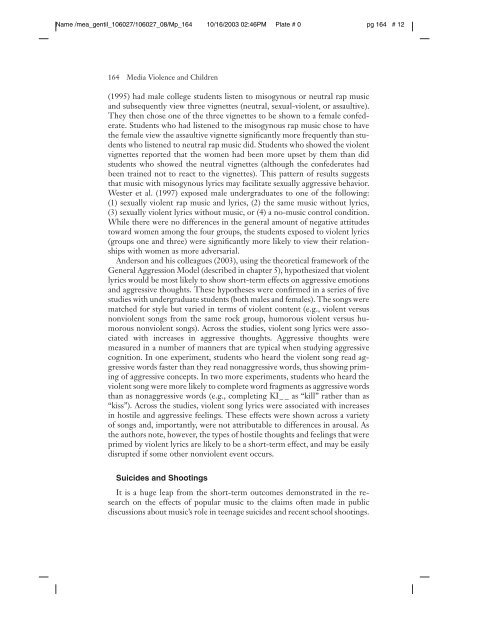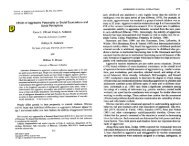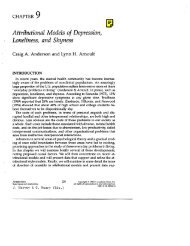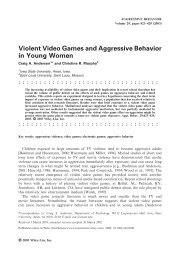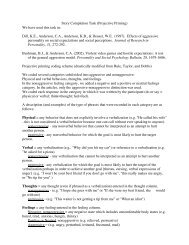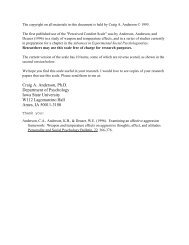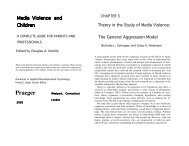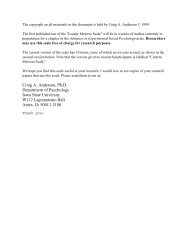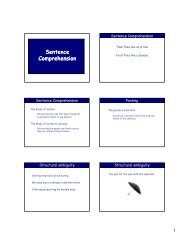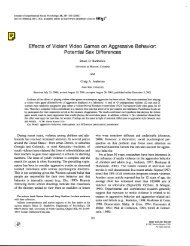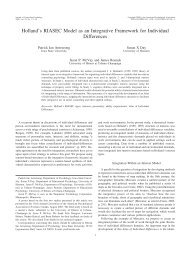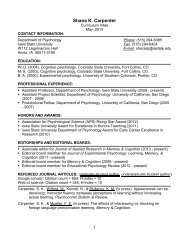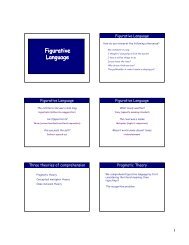The Effects of Violent Music on Children and Adolescents
The Effects of Violent Music on Children and Adolescents
The Effects of Violent Music on Children and Adolescents
Create successful ePaper yourself
Turn your PDF publications into a flip-book with our unique Google optimized e-Paper software.
Name /mea_gentil_106027/106027_08/Mp_164 10/16/2003 02:46PM Plate # 0 pg 164 # 12<br />
164 Media Violence <strong>and</strong> <strong>Children</strong><br />
(1995) had male college students listen to misogynous or neutral rap music<br />
<strong>and</strong> subsequently view three vignettes (neutral, sexual-violent, or assaultive).<br />
<str<strong>on</strong>g>The</str<strong>on</strong>g>y then chose <strong>on</strong>e <str<strong>on</strong>g>of</str<strong>on</strong>g> the three vignettes to be shown to a female c<strong>on</strong>federate.<br />
Students who had listened to the misogynous rap music chose to have<br />
the female view the assaultive vignette significantly more frequently than students<br />
who listened to neutral rap music did. Students who showed the violent<br />
vignettes reported that the women had been more upset by them than did<br />
students who showed the neutral vignettes (although the c<strong>on</strong>federates had<br />
been trained not to react to the vignettes). This pattern <str<strong>on</strong>g>of</str<strong>on</strong>g> results suggests<br />
that music with misogynous lyrics may facilitate sexually aggressive behavior.<br />
Wester et al. (1997) exposed male undergraduates to <strong>on</strong>e <str<strong>on</strong>g>of</str<strong>on</strong>g> the following:<br />
(1) sexually violent rap music <strong>and</strong> lyrics, (2) the same music without lyrics,<br />
(3) sexually violent lyrics without music, or (4) a no-music c<strong>on</strong>trol c<strong>on</strong>diti<strong>on</strong>.<br />
While there were no differences in the general amount <str<strong>on</strong>g>of</str<strong>on</strong>g> negative attitudes<br />
toward women am<strong>on</strong>g the four groups, the students exposed to violent lyrics<br />
(groups <strong>on</strong>e <strong>and</strong> three) were significantly more likely to view their relati<strong>on</strong>ships<br />
with women as more adversarial.<br />
Anders<strong>on</strong> <strong>and</strong> his colleagues (2003), using the theoretical framework <str<strong>on</strong>g>of</str<strong>on</strong>g> the<br />
General Aggressi<strong>on</strong> Model (described in chapter 5), hypothesized that violent<br />
lyrics would be most likely to show short-term effects <strong>on</strong> aggressive emoti<strong>on</strong>s<br />
<strong>and</strong> aggressive thoughts. <str<strong>on</strong>g>The</str<strong>on</strong>g>se hypotheses were c<strong>on</strong>firmed in a series <str<strong>on</strong>g>of</str<strong>on</strong>g> five<br />
studies with undergraduate students (both males <strong>and</strong> females). <str<strong>on</strong>g>The</str<strong>on</strong>g> s<strong>on</strong>gs were<br />
matched for style but varied in terms <str<strong>on</strong>g>of</str<strong>on</strong>g> violent c<strong>on</strong>tent (e.g., violent versus<br />
n<strong>on</strong>violent s<strong>on</strong>gs from the same rock group, humorous violent versus humorous<br />
n<strong>on</strong>violent s<strong>on</strong>gs). Across the studies, violent s<strong>on</strong>g lyrics were associated<br />
with increases in aggressive thoughts. Aggressive thoughts were<br />
measured in a number <str<strong>on</strong>g>of</str<strong>on</strong>g> manners that are typical when studying aggressive<br />
cogniti<strong>on</strong>. In <strong>on</strong>e experiment, students who heard the violent s<strong>on</strong>g read aggressive<br />
words faster than they read n<strong>on</strong>aggressive words, thus showing priming<br />
<str<strong>on</strong>g>of</str<strong>on</strong>g> aggressive c<strong>on</strong>cepts. In two more experiments, students who heard the<br />
violent s<strong>on</strong>g were more likely to complete word fragments as aggressive words<br />
than as n<strong>on</strong>aggressive words (e.g., completing KI_ _ as “kill” rather than as<br />
“kiss”). Across the studies, violent s<strong>on</strong>g lyrics were associated with increases<br />
in hostile <strong>and</strong> aggressive feelings. <str<strong>on</strong>g>The</str<strong>on</strong>g>se effects were shown across a variety<br />
<str<strong>on</strong>g>of</str<strong>on</strong>g> s<strong>on</strong>gs <strong>and</strong>, importantly, were not attributable to differences in arousal. As<br />
the authors note, however, the types <str<strong>on</strong>g>of</str<strong>on</strong>g> hostile thoughts <strong>and</strong> feelings that were<br />
primed by violent lyrics are likely to be a short-term effect, <strong>and</strong> may be easily<br />
disrupted if some other n<strong>on</strong>violent event occurs.<br />
Suicides <strong>and</strong> Shootings<br />
It is a huge leap from the short-term outcomes dem<strong>on</strong>strated in the research<br />
<strong>on</strong> the effects <str<strong>on</strong>g>of</str<strong>on</strong>g> popular music to the claims <str<strong>on</strong>g>of</str<strong>on</strong>g>ten made in public<br />
discussi<strong>on</strong>s about music’s role in teenage suicides <strong>and</strong> recent school shootings.


